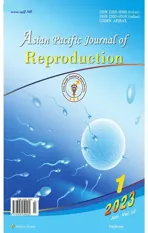Serum anti-leukemia inhibitory factor antibody and recurrent pregnancy loss in Iranian women
2023-02-17SeyedMohammadSeifatiHosseinAnsariniyaFatemeRahmaniAliAkbarSaboorYaraghiFarzanehFesahatHosseinHadinedoushanFatemeZare
Seyed Mohammad Seifati ,Hossein Ansariniya,2 ,Fateme Rahmani ,Ali Akbar Saboor-Yaraghi ,Farzaneh Fesahat ,Hossein Hadinedoushan ,Fateme Zare✉
1Reproductive Immunology Research Center,Shahid Sadoughi University of Medical Sciences,Yazd,Iran
2Department of Immunology,School of Medicine,Shahid Beheshti University of Medical Sciences,Tehran,Iran
3Department of Immunology,School of Public Health,Tehran University of Medical Sciences,Tehran,Iran
Recurrent pregnancy loss is defined by the World Health Orgnization as the loss of three or more consecutive pregnancies before the 20th week[1].According to studies,the prevalence of this disorder in Europe and America is between 1% and 4% for women of reproductive age.Various etiologies including uterine factors,thrombophilia,endocrine,physiological,genetic,and immunological factors are considered risk factors for recurrent pregnancy loss.Leukemia inhibitory factor (LIF) is a member of the interleukin (IL)-6 family with a pleiotropic role that plays an essential role in the implantation process of mammals[2,3].Targeted mutation in murine LIF gene causes infertility.
In mice with defects in LIF,implantation fails,while the implantation process is saved by injecting exogenous LIF.Blocking LIF signaling using antibody or inhibitor causes a significant reduction in the number of implantation[4].For example,injection of LIF antagonist together with polyethylene glycol inhibits implantation in mice[5].Moreover,injection of anti-LIF antibody into the monkey and mouse uterus reduces blastocyst implantation[4].
Based on the above findings,we investigated the serum level of anti-LIF antibody in Iranian women with recurrent pregnancy loss and determined its relationship.In this case-control study,40 participants were considered (α=0.05,β=0.2) in each group.The case group consisted of women who had a history of two or more recurrent pregnancy loss.The inclusion and exclusion criteria of the study participants are depicted in Figure 1.We measured anti-LIF antibody levels by enzyme-linked immunosorbent assay with a home-made kit.

Figure 1.Flowchart of the group categorisation in this study.LIF: leukemia inhibitory factor.TORCH refers to toxoplasmosis,other agents,rubella (or German measles),cytomegalovirus,and herpes simplex.
Women with a history of recurrent pregnancy loss had a mean maternal ages of (30.1±4.3;mean±SD) years and those without a history of recurrent pregnancy loss had mean maternal ages of (30.0±4.2;mean±SD) years.Women in the two groups were not significantly different in terms of their maternal age.In the case group,recurrent pregnancy loss ranged from two to six (4.0±1.5;mean±SD).The control group had one to four successful pregnancies (2.1±0.9;mean±SD).Based on the results obtained from this study,the average level of anti-LIF antibody in the control group was (130.3±13.63;mean±SEM) pg/mL and the average level in the case group was (146.3±13.45;mean±SEM) pg/mL.There was no significant difference in the level of anti-LIF antibody between the case and control groups.It seems that the blocking of LIF by the antibody produced against it may be involved in the pathogenesis of recurrent pregnancy loss,but the results of our study did not show any difference between the two groups.
In conclusion,the present study displays the serum level of anti-LIF antibody is higher in the case group compared to the control group,but this difference is not significant.Due to the novel nature of this study in patients with recurrent pregnancy loss,it is suggested to conduct this study in a larger statistical population.
Conflict of interest statement
The authors declare that there is no conflict of interest.
Funding
This study received no extramural funding.
Authors’ contributions
Ali Akbar Saboor-Yaraghi carried out the conception and design of the research.Fateme Zare carried out the analysis and interpretation of data.Seyed Mohammad Seifati,Fateme Rahmani,Hossein Hadinedoushan and Farzaneh Fesahat participated in design and coordination and helped to draft the manuscript and revise the manuscript for important intellectual content.The first draft of the manuscript was written by Hossein Ansariniya.All authors read and approved the final manuscript.
杂志排行
Asian Pacific Journal of Reproduction的其它文章
- The fate of surplus embryos in the setting of assisted reproductive technology: A scoping review
- Embryo quality and chromosomal abnormality in embryos from couples undergoing assisted reproductive technology using preimplantation genetic screening
- A novel herbal combination ameliorates ovarian dysfunction and regulates altered biochemical parameters in rats with letrozole-induced polycystic ovary syndrome
- Impact of chronological ageing on semen parameters in southern Indian men visiting infertility centre: A retrospective study
- Bacteriospermia among smallholder artificial insemination boars in the Philippines and potential associated factors
- Effects of N-acetylcysteine on growth,viability and reactive oxygen species levels in small antral follicles cultured in vitro
